Quantify Runoff Reduction in the Zhang River Due to Water Diversion for Irrigation
Abstract
:1. Introduction
2. Materials and Methods
2.1. Study Area
2.2. Geospatial Data
2.3. Hydro-Meteorological Datasets
2.4. Mann–Kendall Mutation Test
2.5. Runoff Attribution Analysis Method
2.6. SWAT Model
3. Results
3.1. Mutation Test Result
3.2. Runoff Simulation
3.3. Runoff Attribution Analysis
- Climate change
- Human activities
4. Discussion
5. Conclusions
- (1)
- Under the influence of both climate change and human activities, the runoff volume in the Zhanghe River basin has decreased significantly. The average flow change in the basin before and after the abrupt change point was 38.62 m3/s. The analysis results of the SWAT model simulation and the runoff reversion model showed that the percentage of runoff change caused by climate change in the basin was 36.2%, while the percentage of runoff change under the influence of human activities was 63.8%.
- (2)
- The main influencing factor of meteorological elements is the change in precipitation. For this watershed, the decrease in flood precipitation was the main climatic factor, which also led to more canal diversions for the irrigation of summer crops. Among the influencing factors of human activities, agricultural production is the main target of water consumption in Zhanghe River Basin, with an average water consumption ratio of 63.39%.
- (3)
- It can be seen that the dominant factor of canal diversions is gradually changing from the water supply of wheat-based winter cereals to the water supply of maize-based summer crops, and the overall water diversions have risen with the growth of agricultural land and the rise of river runoff. Moreover, from the ratios between different canal diversions and their irrigation areas, irrigation water for summer crops in Hebei Province has gradually become one of the dominant factors affecting the overall outflow of the basin.
Author Contributions
Funding
Institutional Review Board Statement
Informed Consent Statement
Data Availability Statement
Conflicts of Interest
References
- Li, P.; Qian, H. Water resource development and protection in loess areas of the world: A summary to the thematic issue of water in loess. Environ. Earth Sci. 2018, 77, 796. [Google Scholar] [CrossRef]
- Zheng, H.; Zhang, L.; Zhu, R.; Liu, C.; Sato, Y.; Fukushima, Y. Responses of streamflow to climate and land surface change in the headwaters of the Yellow River Basin. Water Resour. Res. 2009, 45, 7. [Google Scholar] [CrossRef]
- Erler, A.R.; Frey, S.K.; Khader, O.; D’Orgeville, M.; Park, Y.; Hwang, H.; Lapen, D.R.; Peltier, W.R.; Sudicky, E.A. Simulating Climate Change Impacts on Surface Water Resources Within a Lake-Affected Region Using Regional Climate Projections. Water Resour. Res. 2019, 55, 130–155. [Google Scholar] [CrossRef]
- Wu, J.; Miao, C.; Wang, Y.; Duan, Q.; Zhang, X. Contribution analysis of the long-term changes in seasonal runoff on the Loess Plateau, China, using eight Budyko-based methods. J. Hydrol. 2017, 545, 263–275. [Google Scholar] [CrossRef]
- Lotz, T.; Opp, C.; He, X. Factors of runoff generation in the Dongting Lake basin based on a SWAT model and implications of recent land cover change. Quat. Int. 2018, 475, 54–62. [Google Scholar] [CrossRef]
- Hasan, E.; Tarhule, A.; Kirstetter, P.-E.; Clark, R.; Hong, Y. Runoff sensitivity to climate change in the Nile River Basin. J. Hydrol. 2018, 561, 312–321. [Google Scholar] [CrossRef]
- Feng, X. Characteristics of Runoff Variation in Dalinghe River Basin in Recent 50 Years. J. China Hydrol. 2017, 37, 84–90. (In Chinese) [Google Scholar]
- Hu, J.; Ma, J.; Nie, C.; Xue, L.; Zhang, Y.; Ni, F.; Deng, Y.; Liu, J.; Zhou, D.; Li, L.; et al. Attribution Analysis of Runoff Change in Min-Tuo River Basin based on SWAT model simulations, China. Sci. Rep. 2020, 10, 2900. [Google Scholar] [CrossRef] [Green Version]
- Coles, A.; McConkey, B.; McDonnell, J. Climate change impacts on hillslope runoff on the northern Great Plains, 1962–2013. J. Hydrol. 2017, 550, 538–548. [Google Scholar] [CrossRef]
- Lv, A.; Qi, S.; Wang, G. Multi-model driven by diverse precipitation datasets increases confidence in identifying dominant factors for runoff change in a subbasin of the Qaidam Basin of China. Sci. Total Environ. 2021, 802, 149831. [Google Scholar] [CrossRef]
- Triet, N.V.K.; Dung, N.V.; Hoang, L.P.; Le Duy, N.; Tran, D.D.; Anh, T.T.; Kummu, M.; Merz, B.; Apel, H. Future projections of flood dynamics in the Vietnamese Mekong Delta. Sci. Total Environ. 2020, 742, 140596. [Google Scholar] [CrossRef] [PubMed]
- Tran, D.D.; van Halsema, G.; Hellegers, P.J.G.J.; Hoang, L.P.; Tran, T.Q.; Kummu, M.; Ludwig, F. Assessing impacts of dike construction on the flood dynamics of the Mekong Delta. Hydrol. Earth Syst. Sci. 2018, 22, 1875–1896. [Google Scholar] [CrossRef] [Green Version]
- Dang, V.H.; Tran, D.D.; Cham, D.D.; Hang, P.T.T.; Nguyen, H.T.; Van Truong, H.; Tran, P.H.; Duong, M.B.; Nguyen, N.T.; Van Le, K.; et al. Assessment of Rainfall Distributions and Characteristics in Coastal Provinces of the Vietnamese Mekong Delta under Climate Change and ENSO Processes. Water 2020, 12, 1555. [Google Scholar] [CrossRef]
- Yang, Y.; Tian, F. Abrupt change of runoff and its major driving factors in Haihe River Catchment, China. J. Hydrol. 2009, 374, 373–383. [Google Scholar] [CrossRef]
- Bin, L.; Xu, K.; Xu, X.; Lian, J.; Ma, C. Development of a landscape indicator to evaluate the effect of landscape pattern on surface runoff in the Haihe River Basin. J. Hydrol. 2018, 566, 546–557. [Google Scholar] [CrossRef]
- Wang, D.; Yu, X.; Jia, G.; Wang, H. Sensitivity analysis of runoff to climate variability and land-use changes in the Haihe Basin mountainous area of north China. Agric. Ecosyst. Environ. 2018, 269, 193–203. [Google Scholar] [CrossRef]
- Zhang, Q.; Liu, J.; Yu, X.; Chen, L. Scale effects on runoff and a decomposition analysis of the main driving factors in Haihe Basin mountainous area. Sci. Total Environ. 2019, 690, 1089–1099. [Google Scholar] [CrossRef]
- Zhang, L.; Karthikeyan, R.; Bai, Z.; Srinivasan, R. Analysis of streamflow responses to climate variability and land use change in the Loess Plateau region of China. Catena 2017, 154, 1–11. [Google Scholar] [CrossRef]
- Luan, X.; Wu, P.; Sun, S.; Wang, Y.; Gao, X. Quantitative study of the crop production water footprint using the SWAT model. Ecol. Indic. 2018, 89, 1–10. [Google Scholar] [CrossRef]
- Dias, V.D.S.; da Luz, M.P.; Medero, G.M.; Nascimento, D.T.F.; De Oliveira, W.N.; Merelles, L.R.D.O. Historical Streamflow Series Analysis Applied to Furnas HPP Reservoir Watershed Using the SWAT Model. Water 2018, 10, 458. [Google Scholar] [CrossRef] [Green Version]
- Aznarez, C.; Jimeno-Sáez, P.; López-Ballesteros, A.; Pacheco, J.; Senent-Aparicio, J. Analysing the Impact of Climate Change on Hydrological Ecosystem Services in Laguna del Sauce (Uruguay) Using the SWAT Model and Remote Sensing Data. Remote Sens. 2021, 13, 2014. [Google Scholar] [CrossRef]
- Meshesha, T.W.; Wang, J.; Melaku, N.D.; McClain, C.N. Modelling groundwater quality of the Athabasca River Basin in the subarctic region using a modified SWAT model. Sci. Rep. 2021, 11, 13574. [Google Scholar] [CrossRef] [PubMed]
- Qi, P.; Xia, Z.; Zhang, G.; Zhang, W.; Chang, Z. Effects of climate change on agricultural water resource carrying capacity in a high-latitude basin. J. Hydrol. 2021, 597, 126328. [Google Scholar] [CrossRef]
- Hoshiyar, S.M.S.; Pirmoradian, N.; Ashrafzadeh, A.; Rizi, A.P. Performance Assessment of a Water Delivery Canal to Improve Agricultural Water Distribution. Water Resour. Manag. 2021, 35, 2487–2501. [Google Scholar] [CrossRef]
- Dai, X.; Han, Y.; Zhang, X.; Li, D.; Chen, J.; Keshavarz, M.; García-García, P.L.; Ruelas-Monjardín, L.; Marín-Muñíz, J.L.; De, I.; et al. Impacts on the utilization degree of canal water caused by agricultural water reallocation: A case study from China. Water Policy 2015, 17, 815–830. [Google Scholar] [CrossRef]
- Nishida, K.; Harashima, T.; Yoshida, S.; Ohno, S. Water flow resistance along the pathway from the plow layer to the drainage canal via subsurface drainage in a paddy field. Agric. Water Manag. 2020, 242, 106391. [Google Scholar] [CrossRef]
- Yousaf, W.; Awan, W.K.; Kamran, M.; Ahmad, S.R.; Bodla, H.U.; Riaz, M.; Umar, M.; Chohan, K. A paradigm of GIS and remote sensing for crop water deficit assessment in near real time to improve irrigation distribution plan. Agric. Water Manag. 2020, 243, 106443. [Google Scholar] [CrossRef]
- Liu, J.; Yang, T.; Chen, Q.; Liu, F.; Wang, B. Distribution and potential ecological risk of heavy metals in the typical eco-units of Haihe River Basin. Front. Environ. Sci. Eng. 2014, 10, 103–113. [Google Scholar] [CrossRef]
- Bao, Z.; Zhang, J.; Wang, G.; Fu, G.; He, R.; Yan, X.; Jin, J.; Liu, Y.; Zhang, A. Attribution for decreasing streamflow of the Haihe River basin, northern China: Climate variability or human activities? J. Hydrol. 2012, 460–461, 117–129. [Google Scholar] [CrossRef]
- Kendall, M.G. Rank correlation methods. Brit. J. Psychol. 1990, 25, 86–91. [Google Scholar] [CrossRef]
- Arnold, J.; Allen, P. Estimating hydrologic budgets for three Illinois watersheds. J. Hydrol. 1996, 176, 57–77. [Google Scholar] [CrossRef]
- Sun, C.; Ren, L. Assessment of surface water resources and evapotranspiration in the Haihe River basin of China using SWAT model. Hydrol. Process. 2012, 27, 1200–1222. [Google Scholar] [CrossRef]
- Sun, C.; Ren, L. Assessing crop yield and crop water productivity and optimizing irrigation scheduling of winter wheat and summer maize in the Haihe plain using SWAT model. Hydrol. Process. 2013, 28, 2478–2498. [Google Scholar] [CrossRef]
- Bu, J.; Lu, C.; Niu, J.; Gao, Y. Attribution of Runoff Reduction in the Juma River Basin to Climate Variation, Direct Human Intervention, and Land Use Change. Water 2018, 10, 1775. [Google Scholar] [CrossRef] [Green Version]
- Zhang, X.; Ren, L. Simulating and assessing the effects of seasonal fallow schemes on the water-food-energy nexus in a shallow groundwater-fed plain of the Haihe River basin of China. J. Hydrol. 2021, 595, 125992. [Google Scholar] [CrossRef]
- Jin, J.; Wang, G.; Zhang, J.; Yang, Q.; Liu, C.; Liu, Y.; Bao, Z.; He, R. Impacts of climate change on hydrology in the Yellow River source region, China. J. Water Clim. Chang. 2018, 11, 916–930. [Google Scholar] [CrossRef]
- Johnston, R.; Smakhtin, V. Hydrological Modeling of Large river Basins: How Much is Enough? Water Resour. Manag. 2014, 28, 2695–2730. [Google Scholar] [CrossRef] [Green Version]
- Nguyen, H.H.; Peche, A.; Venohr, M. Modelling of sewer exfiltration to groundwater in urban wastewater systems: A critical review. J. Hydrol. 2021, 596, 126130. [Google Scholar] [CrossRef]
- Singh, A.; Jha, S.K. Identification of sensitive parameters in daily and monthly hydrological simulations in small to large catchments in Central India. J. Hydrol. 2021, 601, 126632. [Google Scholar] [CrossRef]
- Mosbahi, M.; Benabdallah, S.; Boussema, M.R. Sensitivity analysis of a GIS-based model: A case study of a large semi-arid catchment. Earth Sci. Inform. 2014, 8, 569–581. [Google Scholar] [CrossRef]
- Mourad, A.; El Messari, J.E.; Ismail, H.; Abdelmounim, B.; Gabriel, M.J.; Loubna, B.; Reda, A.M. Assessment of the SWAT Model and the Parameters Affecting the Flow Simulation in the Watershed of Oued Laou (Northern Morocco). J. Ecol. Eng. 2019, 20, 104–113. [Google Scholar] [CrossRef]
- Yesuf, H.M.; Assen, M.; Alamirew, T.; Melesse, A. Modeling of sediment yield in Maybar gauged watershed using SWAT, northeast Ethiopia. Catena 2015, 127, 191–205. [Google Scholar] [CrossRef]
- Wei, L.; Changxing, S.; Yuanyuan, Z. Trends and attribution of runoff changes in the upper and middle reaches of the Yellow River in China. J. Hydro-Environ. Res. 2021, 37, 57–66. [Google Scholar] [CrossRef]
- Bhatti, A.Z.; Farooque, A.A.; Krouglicof, N.; Peters, W.; Acharya, B.; Li, Q.; Ahsan, M.S. Climate change impacts on precipitation and temperature in Prince Edward Island, Canada. World Water Policy 2021, 7, 9–29. [Google Scholar] [CrossRef]
- Escanilla-Minchel, R.; Alcayaga, H.; Soto-Alvarez, M.; Kinnard, C.; Urrutia, R. Evaluation of the Impact of Climate Change on Runoff Generation in an Andean Glacier Watershed. Water 2020, 12, 3547. [Google Scholar] [CrossRef]
- Huntington, J.L.; Niswonger, R.G. Role of surface-water and groundwater interactions on projected summertime streamflow in snow dominated regions: An integrated modeling approach. Water Resour. Res. 2012, 48. [Google Scholar] [CrossRef] [Green Version]
- Li, Y.; He, D.; Li, X.; Zhang, Y.; Yang, L. Contributions of Climate Variability and Human Activities to Runoff Changes in the Upper Catchment of the Red River Basin, China. Water 2016, 8, 414. [Google Scholar] [CrossRef] [Green Version]
- Zhao, X.; Huang, J.; Wu, P.; Gao, X. The dynamic effects of pastures and crop on runoff and sediments reduction at loess slopes under simulated rainfall conditions. Catena 2014, 119, 1–7. [Google Scholar] [CrossRef]
- Hu, Y.; Moiwo, J.P.; Yang, Y.; Han, S.; Yang, Y. Agricultural water-saving and sustainable groundwater management in Shijiazhuang Irrigation District, North China Plain. J. Hydrol. 2010, 393, 219–232. [Google Scholar] [CrossRef]
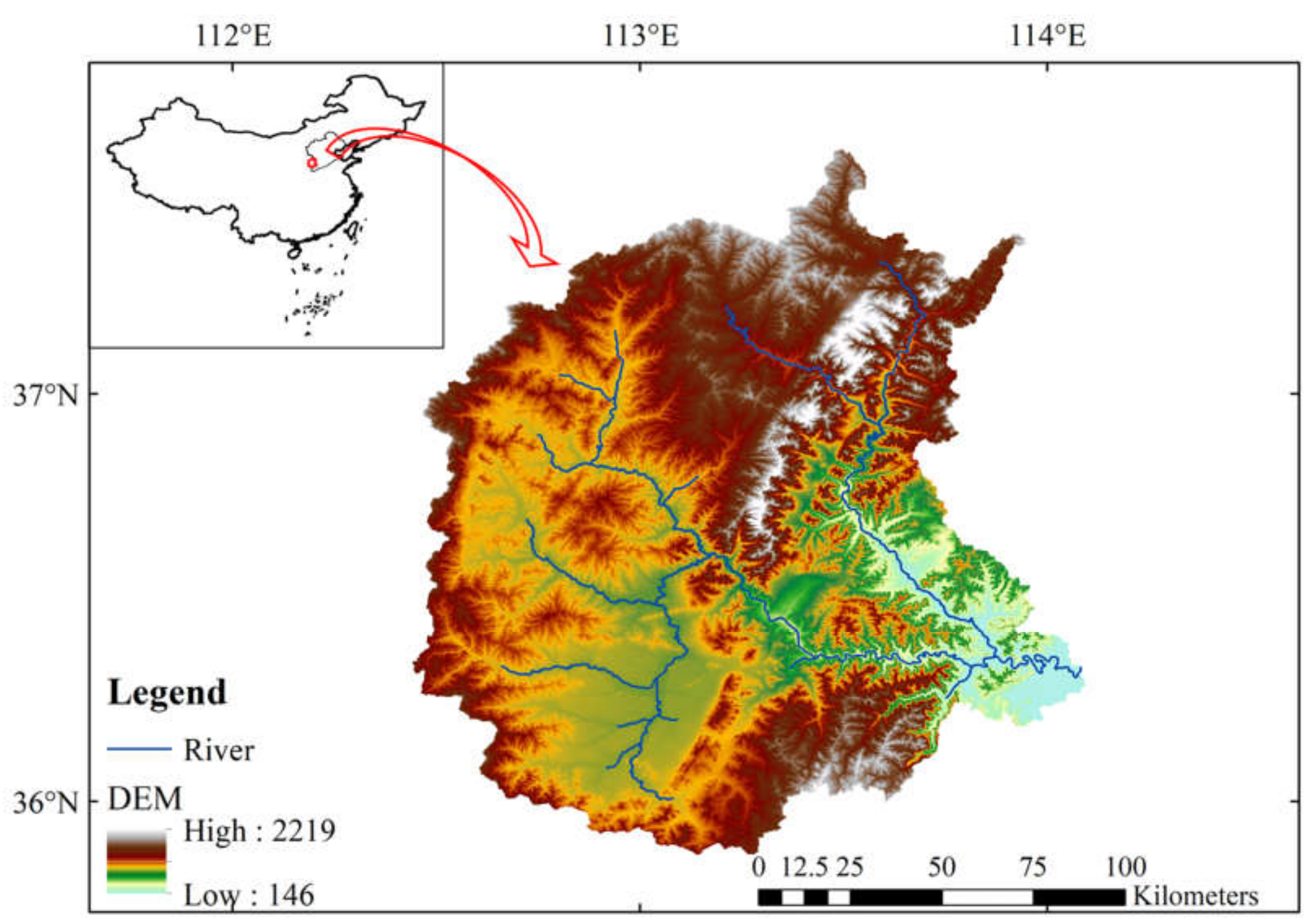
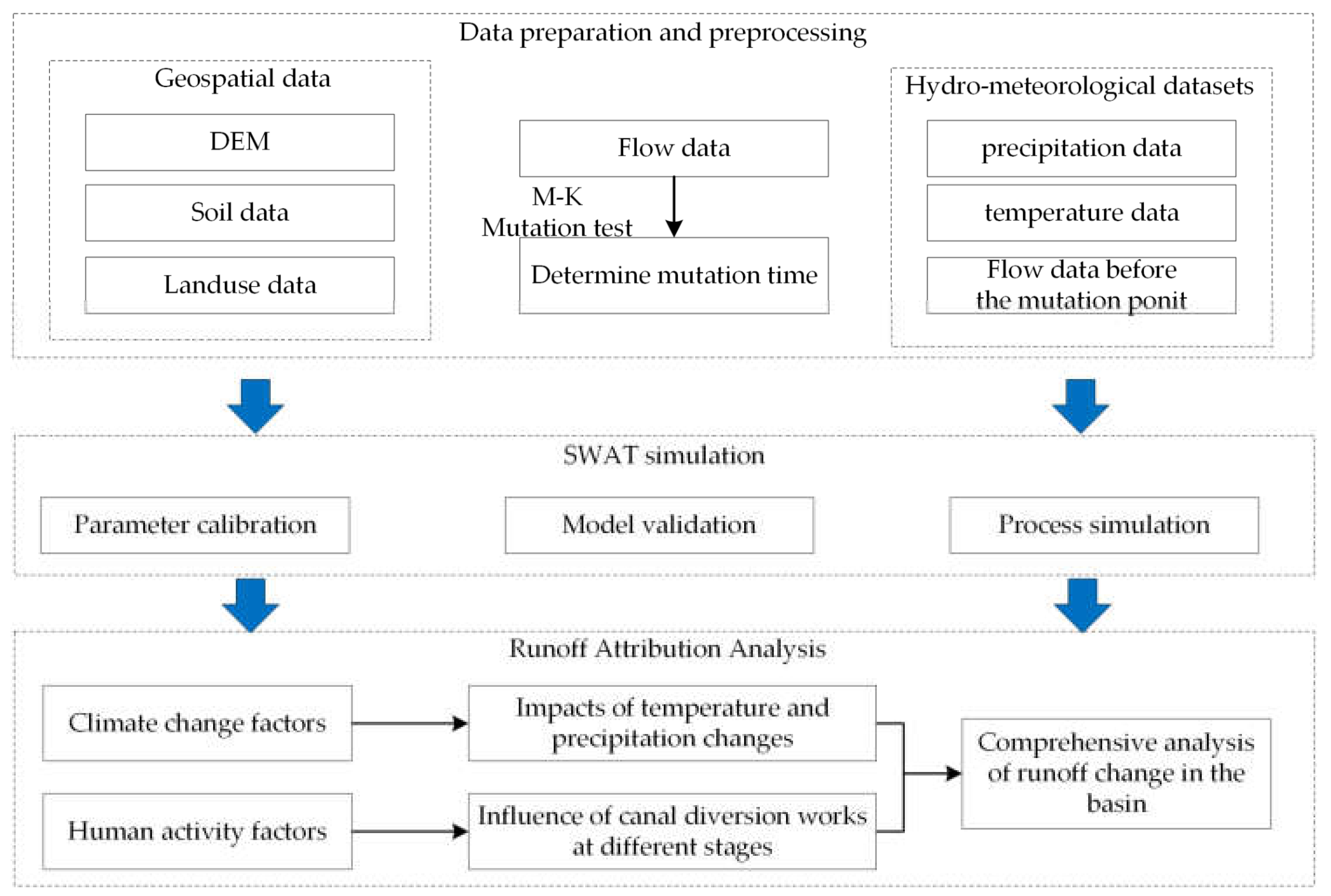


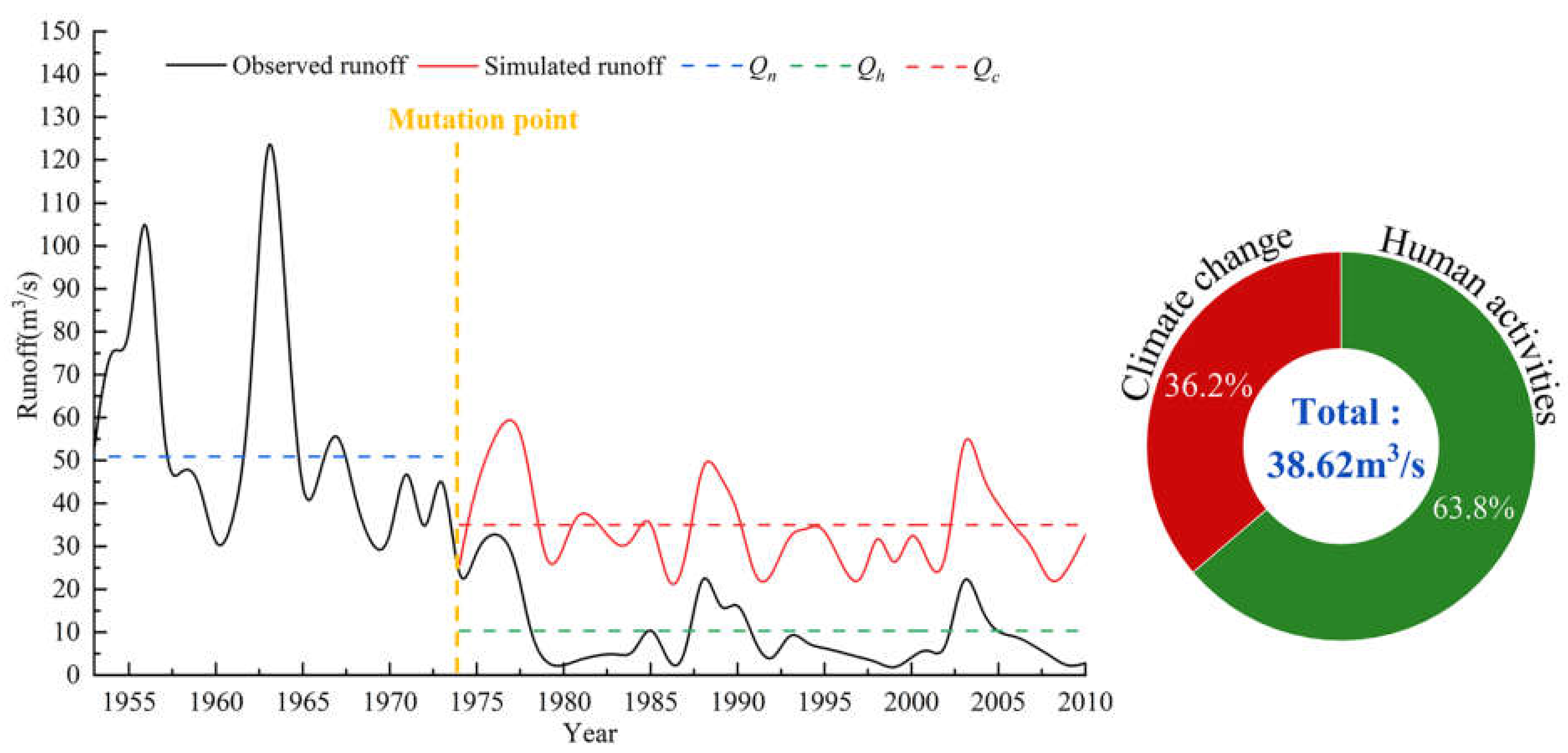
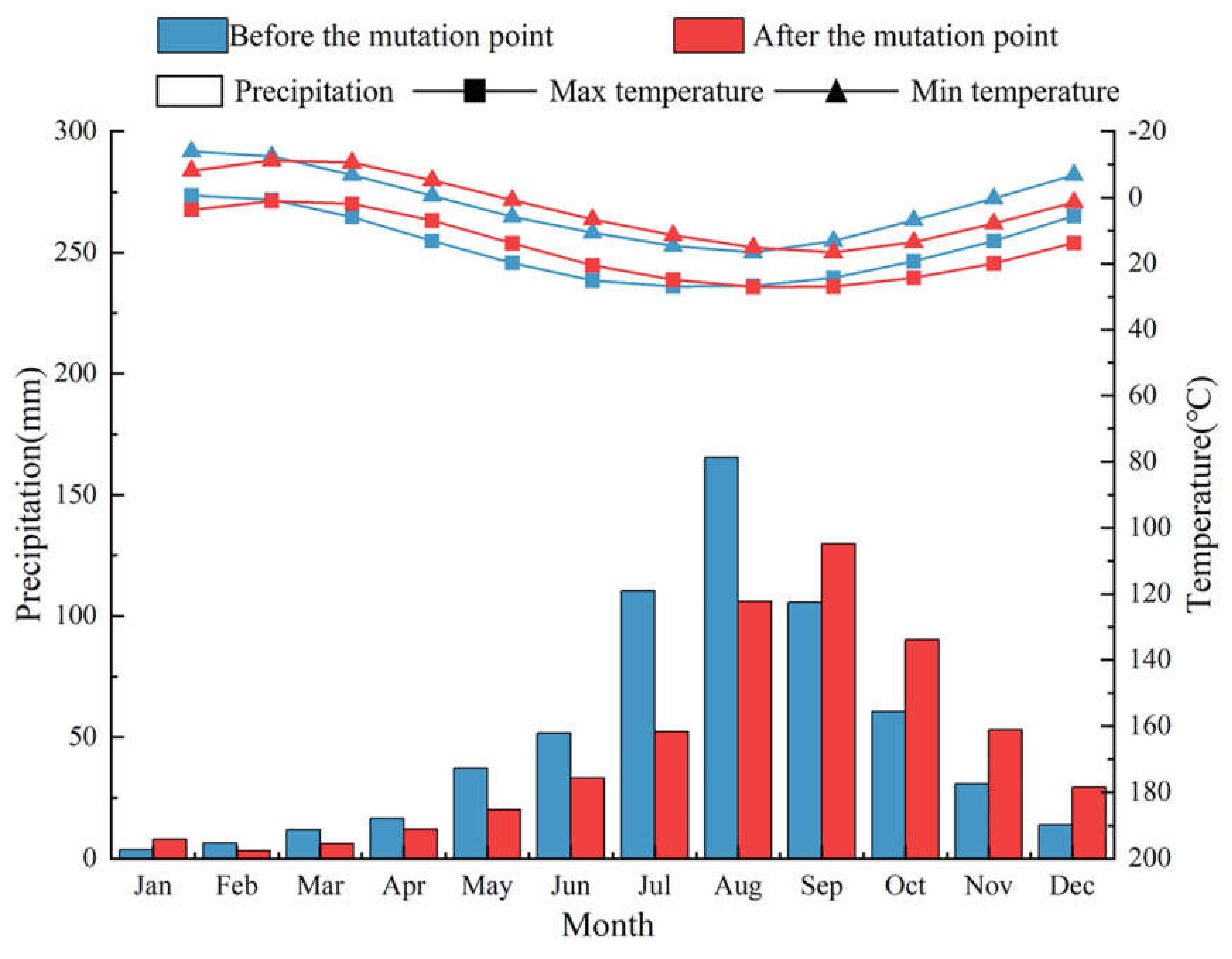

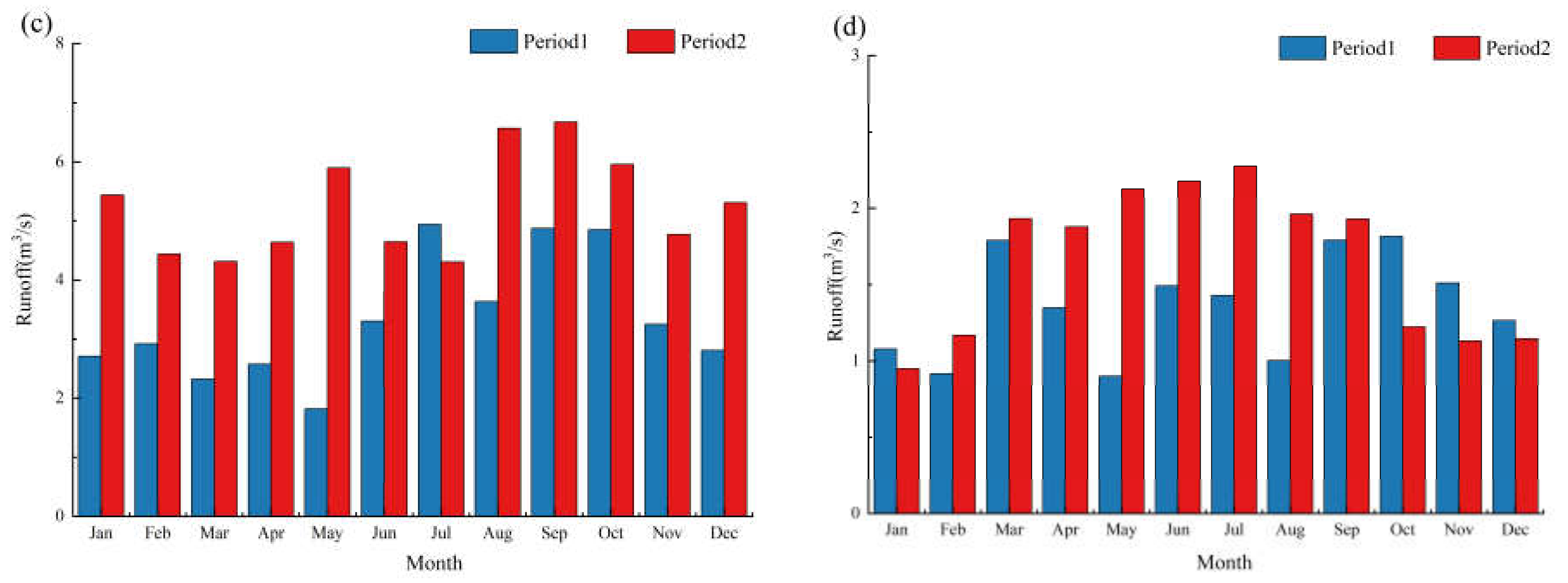

| Station Name | Starting Time | Type | Time Scale |
|---|---|---|---|
| Guantai | 1951 | Hydrological stations& Meteorological stations | daily |
| Shexian | 1950 | Meteorological stations | daily |
| Liujiazhuang | 1953 | Meteorological stations | daily |
| Kuangmenkou | 1953 | Meteorological stations | daily |
| Tianqiaoduan | 1958 | Meteorological stations | daily |
| Yincheng | 1952 | Meteorological stations | daily |
| Changzi | 1953 | Meteorological stations | daily |
| Guxian | 1953 | Meteorological stations | daily |
| Shipan | 1953 | Meteorological stations | daily |
| Quandian | 1953 | Meteorological stations | daily |
| Panlong | 1953 | Meteorological stations | daily |
| Xihandan | 1952 | Meteorological stations | daily |
| Shiliang | 1952 | Meteorological stations | daily |
| Hengling | 1951 | Meteorological stations | daily |
| Xiajiaozhang | 1952 | Meteorological stations | daily |
| Parameter | Ranges | Calibration Value |
|---|---|---|
| r__CN2.mgt | −0.2–0.2 | −0.083 |
| v__ALPHA_BF.gw | 0–1 | 0.600 |
| v__GW_DELAY.gw | 0–500 | 85.118 |
| v__GWQMN.gw | 0–5000 | 608.789 |
| v__ESCO.hru | 0–1 | 0.635 |
| v__ALPHA_BNK.rte | 0–1 | 0.551 |
| v__SOL_AWC.sol | 0–1 | 0.671 |
| v__SOL_K.sol | 0–2000 | 173.191 |
| v__SOL_BD.sol | 0.9–2.5 | 1.308 |
| v__SLSUBBSN.hru | 10–150 | 101.439 |
| Year | Total Diversion Flow | Remaining Flow | Diversion Ratio |
|---|---|---|---|
| 1995 | 14.21 | 47.02 | 23.20% |
| 1996 | 15.43 | 7.62 | 66.94% |
| 1997 | 14.39 | 5.51 | 72.31% |
| 1998 | 12.20 | 3.29 | 78.76% |
| 1999 | 8.91 | 4.46 | 66.64% |
| 2000 | 10.05 | 9.55 | 51.28% |
| 2001 | 14.71 | 6.34 | 69.88% |
| 2002 | 17.18 | 24.9 | 40.83% |
| 2003 | 19.39 | 18.69 | 50.92% |
| 2004 | 25.02 | 10.68 | 70.08% |
| 2005 | 20.86 | 13.13 | 61.37% |
| 2006 | 27.54 | 12.33 | 69.07% |
| 2007 | 28.50 | 9.95 | 74.12% |
| 2008 | 20.75 | 3.71 | 84.83% |
| 2009 | 10.69 | 5.08 | 67.79% |
| 2010 | 16.032 | 8.164 | 66.26% |
Publisher’s Note: MDPI stays neutral with regard to jurisdictional claims in published maps and institutional affiliations. |
© 2022 by the authors. Licensee MDPI, Basel, Switzerland. This article is an open access article distributed under the terms and conditions of the Creative Commons Attribution (CC BY) license (https://creativecommons.org/licenses/by/4.0/).
Share and Cite
Chen, X.; Liu, Y.; Zhang, J.; Guan, T.; Sun, Z.; Jin, J.; Liu, C.; Wang, G.; Bao, Z. Quantify Runoff Reduction in the Zhang River Due to Water Diversion for Irrigation. Water 2022, 14, 1918. https://doi.org/10.3390/w14121918
Chen X, Liu Y, Zhang J, Guan T, Sun Z, Jin J, Liu C, Wang G, Bao Z. Quantify Runoff Reduction in the Zhang River Due to Water Diversion for Irrigation. Water. 2022; 14(12):1918. https://doi.org/10.3390/w14121918
Chicago/Turabian StyleChen, Xin, Yanli Liu, Jianyun Zhang, Tiesheng Guan, Zhouliang Sun, Junliang Jin, Cuishan Liu, Guoqing Wang, and Zhenxin Bao. 2022. "Quantify Runoff Reduction in the Zhang River Due to Water Diversion for Irrigation" Water 14, no. 12: 1918. https://doi.org/10.3390/w14121918








